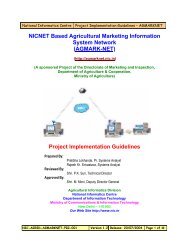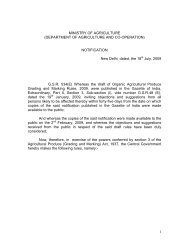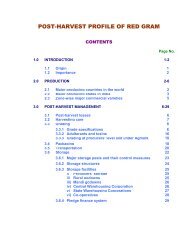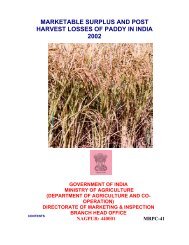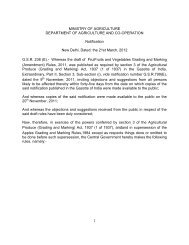Post-Harvest Profile of Grapes - Agmarknet
Post-Harvest Profile of Grapes - Agmarknet
Post-Harvest Profile of Grapes - Agmarknet
Create successful ePaper yourself
Turn your PDF publications into a flip-book with our unique Google optimized e-Paper software.
Botanical description:<br />
<strong>Grapes</strong> belong to the family Vitaceae. Plants are climbing vine which has<br />
thin and smooth shiny leaves. The vines<br />
produce round or oval berries. <strong>Grapes</strong><br />
are borne in clusters, which consist <strong>of</strong><br />
peduncle, rachis and berries. <strong>Grapes</strong><br />
grow in clusters <strong>of</strong> 6 to 300 berries. Fruit<br />
are berries. Berries can be green, black,<br />
blue, golden, purple, red, pink, brown,<br />
peach or white. The berry consists <strong>of</strong><br />
skin, pulp and seeds. The epidermis <strong>of</strong><br />
the skin <strong>of</strong> the berries is composed <strong>of</strong><br />
thick layer <strong>of</strong> cells, which are 5%-12% <strong>of</strong> the total weight <strong>of</strong> the berry. The skin is<br />
covered with cut in or bloom, comprises 1% to 2% <strong>of</strong> skin weight. Most varieties <strong>of</strong><br />
the grapes are self-pollinated.<br />
The genus Vitis is largely distributed between 25° and 50° N latitude in<br />
Europe, the Middle East, North America, and eastern Asia. The genus Vitis is<br />
divided into 2 sub-genera:<br />
1. Euvitis - "True grapes"; characterized by elongated clusters <strong>of</strong> fruit with berries<br />
adhering to stems at maturity, forked tendrils, diaphragms in pith at nodes, also<br />
called "bunch grapes”. Most <strong>of</strong> the cultivated species are in this sub-genera.<br />
2. Muscadinia - Muscadine grapes; characterized by small fruit clusters,<br />
thick-skinned fruit, berries that detach one-by-one as they mature, simple<br />
tendrils, and the lack <strong>of</strong> diaphragms in pith at nodes. There are only 2-3<br />
species in this section.<br />
1.1 ORIGIN:<br />
Cultivation <strong>of</strong> grapes originated in Western Asia and Europe.<br />
1.2 IMPORTANCE:<br />
Grape is one <strong>of</strong> the most delicious fruits. <strong>Grapes</strong> are widely consumed<br />
as fresh fruit in India. It is also used for producing raisins, wine and other<br />
products. The peel <strong>of</strong> grapes is the source <strong>of</strong> essential oil and pectin. It can<br />
also serve as a raw material for the production <strong>of</strong> cattle feed and in<br />
preparation <strong>of</strong> candies. Raisins are rich source <strong>of</strong> sugar most <strong>of</strong> which is<br />
fructose and antioxidants.<br />
<strong>Grapes</strong> production occupies significance in the context that it is the<br />
third most widely cultivated fruit after citrus and banana. Globally grapes<br />
production contributes to about 16% <strong>of</strong> the total fruit production. <strong>Grapes</strong> are<br />
laxative and diuretic. They are useful in fighting dyspepsia, hemorrhoids,<br />
stones in the urinary tract and bile ducts. They also activate liver functions,<br />
ease digestion, help to reduce cholesterol level <strong>of</strong> blood and eliminate uric<br />
6





